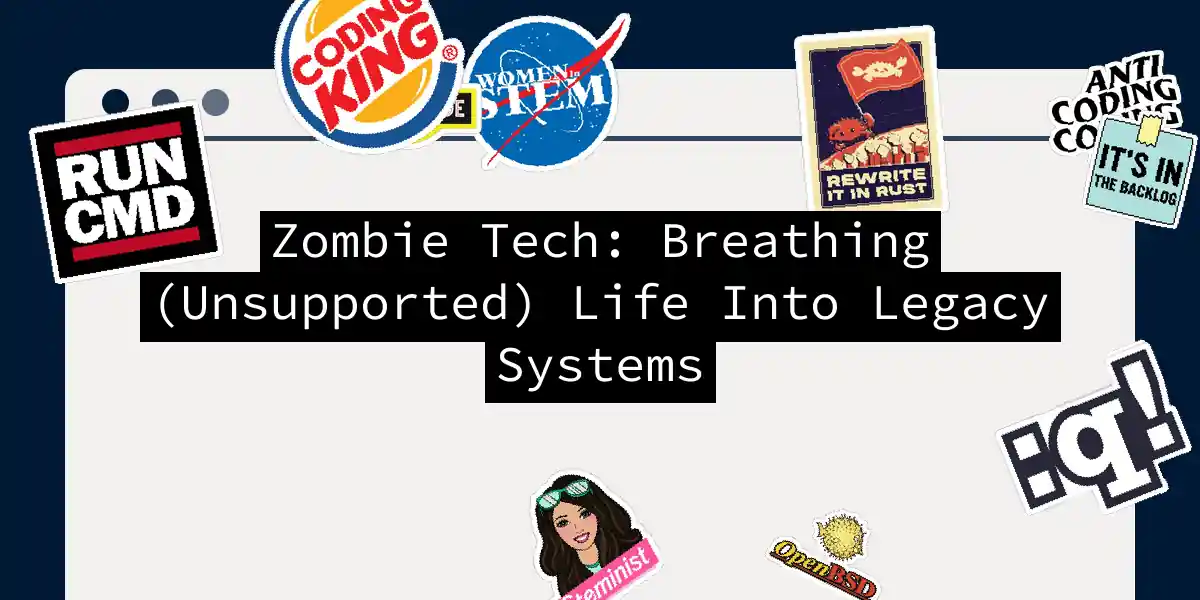Picture this: You’re a digital necromancer, whispering incantations to machines that should’ve retired when flip phones were cool. Your magic? Making unsupported tech not just work, but thrive in modern ecosystems. Let’s grab our metaphysical shovels and dig into the art of legacy resurrection.
The Mausoleum of Obsolete Tech
We’re surrounded by digital ghosts:
- COBOL systems processing your bank transactions (60% of US financial systems, according to IRS spectrometers)
- Windows XP machines running factory floors (looking at you, auto industry)
- Python 2.7 scripts powering that “temporary” analytics solution from 2012
I once found a production Visual Basic 6 app communicating with a React frontend through a series of TXT files and prayer. The file watcher service was called “Thaumiel” (Google it, I’ll wait).
Resurrection Toolkit: 5 Practical Hacks
1. The API Séance
Turn ancient apps into modern microservices with this Python medium:
import datetime
from flask import Flask
import pyodbc # Because sometimes you need to talk to SQL Server 2000
app = Flask(__name__)
@app.route('/get_legacy_data')
def raise_the_dead():
conn = pyodbc.connect('DRIVER={SQL Server};SERVER=localhost;DATABASE=necronomicon;')
cursor = conn.cursor()
cursor.execute("EXEC dbo.GetCustomerData @BloodSacrifice=1")
return {'data': cursor.fetchall(), 'timestamp': datetime.datetime.now().isoformat()}
Pro tip: Wrap it in Docker and pretend it’s “cloud-native.” Investors love that word.
2. The Sandbox Crypt
Isolate your tech zombies with this docker-compose incantation:
version: '3.7'
services:
windows_xp_app:
image: custom-xp-base:1.0
volumes:
- ./necromancy:/root/black_magic
ports:
- "666:80"
networks:
- haunted_network
api_exorcist:
image: nginx:latest
volumes:
- ./spells/nginx.conf:/etc/nginx/conf.d/default.conf
ports:
- "80:80"
This configuration contains the spirit while letting it communicate through controlled channels (like that one aunt who only emails conspiracy theories).
Case Studies from the Crypt
The Good: A major airline still uses AS/400 systems for reservations. Their secret? A WebAssembly transpiler that makes green screens look like React components. Passenger satisfaction increased 40% when they stopped seeing 1980s terminal fonts. The Bad: A hospital chain kept Windows 2000 machines “for compatibility” with MRI machines. They now spend $2M/year on cybersecurity insurance and have a dedicated “Patch Tuesday” team that actually works 24/7. The Ugly: That time I tried to make a dot matrix printer work with AWS Lambda. Let’s just say thermal paper receipts with “AWS Internal Server Error” make interesting modern art.
Survival Guide for Tech Necromancers
- Identify critical organs
Uselsof -n | grep DELto find undead processes clinging to deleted libraries - Build isolation layers
Create API facades faster than vampire hunters building garlic necklaces - Implement deathwatch monitoring
Here’s a Prometheus config snippet that’ll make any legacy system sweat:
rule_files:
- 'deathwatch_rules.yml'
scrape_configs:
- job_name: 'legacy_systems'
static_configs:
- targets: ['192.168.1.66:6666']
metrics_path: '/exorcism_metrics'
- Maintain a kill switch
All legacy integrations need a?bloodmoon=1parameter that triggers immediate shutdown. Test it quarterly during full moons.
The Ethical Séance
While we laugh about tech debt exorcisms, remember the 2017 WannaCry outbreak that crippled NHS hospitals using Windows XP. Sometimes you’re not a necromancer - you’re the IT department doing budget cosplay. So where’s the line? Consider this:
- Is the system mission-critical with no replacement?
- Does maintenance cost less than 5x a rewrite?
- Can you fully isolate it from the network? If you answered “no” to any, maybe stop playing Frankenstein and start writing that migration plan… after one last quick fix. (We all know there’s always one last quick fix.) Now if you’ll excuse me, I need to check on my Windows ME virtual machine that’s been “temporarily” handling GDPR compliance since 2018. It’s almost time for its weekly reboot ritual.
